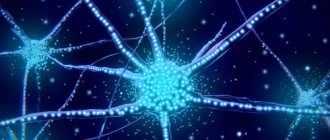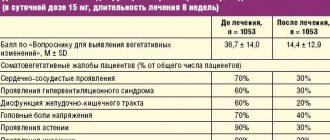Stupefaction is a form of disturbance of consciousness that lasts minutes, hours, days, sometimes weeks. This condition, like a mental disorder, manifests itself in the inability to think clearly, and can also vary between a state where a person confuses places, people, events, time until losing contact with reality itself. This can happen to anyone, regardless of age.
Clouding of consciousness manifests itself in changes in mental activity and has many causes.
Blackout causes
This condition can occur due to head injuries or insufficient supply of oxygen or blood to the brain, which often occurs during a blow.
Confusion and its causes: progressive brain degeneration (Alzheimer's disease), low or very high blood sugar levels, severe mental and emotional shock, dehydration, high temperature up to 40˚C, brain infections (meningitis), urinary tract infections , drinking significant amounts of alcohol and exceeding the permissible limit of doses of sedative medications.
Back Next
Twilight stupefaction is characterized by:
• Sudden emergence and completion.
• Impaired perception of the environment: from fragmentary perception to complete detachment and disorientation.
• Motor sphere: from externally ordered automated behavior to pronounced arousal.
• Options:
- Outpatient automatisms - during clouding of consciousness, a person performs automated actions, behavior may outwardly look correct, the facial expression is detached and gloomy, statements are stereotypical or absent. If accompanied by involuntary wandering: while awake - fugue (several minutes) or trance (longer time, including leaving home, traveling); during sleep - somnambulism (sleepwalking).
- Hallucinatory-delusional twilight stupefaction - the patient is not available for productive contact, but from his behavior it can be assumed that during stupefaction he experiences various types of hallucinations (visual, auditory, including imperative, olfactory, etc.), along with which secondary sensory delusions (persecution, grandeur) are formed. Additionally, there are affective disorders - severe fear, anxiety, anger, enthusiasm, ecstasy. Sometimes they can be accompanied by pronounced agitation with aggression and destructive actions. Fortunately, such conditions are relatively rare and are usually the subject of forensic psychiatric examination.
• After emerging from stupefaction - complete amnesia (for real events and one’s own experiences), often after emerging - weakness, craving for sleep, so they fall asleep in inappropriate places.
• Duration - in most cases from several minutes (usually) to several hours (less often).
Separately designate variants of twilight stupefaction that arose under conditions that force them to be differentiated from “physiological” conditions (usually these cases are associated with the commission of offenses and subsequent forensic psychiatric examination):
- Pathological intoxication is a twilight stupefaction that developed against the background of drinking a small amount of alcohol (alcohol was only a trigger for the condition; there was no actual intoxication). Differentiate with a state of ordinary intoxication.
- Pathological affect is a twilight clouding of consciousness that developed in response to a psychotraumatic event (psychotrauma, usually minor, can only become a trigger for the development of clouding of consciousness). Differentiate with physiological affect (strong emotional excitement).
It is believed that a twilight state of consciousness can develop in patients with epilepsy (as the equivalent of epileptic paroxysm or as a variant of non-convulsive status epilepticus), organic brain damage. In world psychiatry, this type of stupefaction is currently rarely described.
Back Next
To see comments you must register
Stupidity symptoms
The symptoms of this condition include the following manifestations: lack of perception of other people, agitation, disorientation, hallucinations, personality changes, and mood changes; sudden subdepressive mood, strange behavior or irritability, decreased activity, loss of interest in usual activities, long-term memory loss, lack of personal hygiene, difficulty concentrating on a simple task, difficulty thinking and speaking, unpredictability in behavior.
This condition is characterized by a combination of the following symptoms: detachment from reality, inability to adequately perceive the world, complete or partial disorientation in place, time and surrounding persons; mild degree of incoherent thinking; complete or partial impossibility of correct judgments; partial or complete forgetting during this state.
Nervous system damage due to COVID-19
Classification of neurological disorders in covid
Neurological disorders in COVID-19 can be discussed in three sections: (1) neurological features of viral infection, (2) post-infectious neurological complications, (3) infections in patients with neurological comorbidities. Another issue that deserves mention is the precautions regarding infection and treatment of coronavirus infection that should be taken for a special group of neurological patients who require immunosuppressive drugs. The latter group mainly consists of multiple sclerosis, myasthenia gravis and autoimmune encephalitis.
Headache
Headache can be a symptom of a viral infection and usually remains associated with a rise in temperature. Studies have reported headache rates ranging from 6 to 13% with COVID-19. However, concerns have already been raised as to whether this particular symptom is a manifestation of viral meningitis or, for that matter, encephalitis, which may later manifest itself in the form of drowsiness and seizures. Japanese doctors shared their recent experience with a young male patient without any symptoms. or contact or travel history of meningitis before being diagnosed with SARS-CoV-2 infection. The problem becomes more real when considering a report of the detection of the virus in the cerebrospinal fluid of a COVID-19 patient. Another report describes the occurrence of acute hemorrhagic necrotizing encephalopathy in patients with COVID-19. A neurologist needs to pay attention and analyze even a simple symptom like headache in a known case of COVID-19, especially if the headache is disproportionate to the fever and is associated with some other features such as vomiting and changes in sensation.
Cerebrovascular accident
An initial retrospective case series study from Wuhan, China, found that 5.7% of cases of neurological damage in Covid-19 could be attributed to acute cerebrovascular injury. Notably, four cases had ischemic stroke, and cerebral hemorrhage was found in one patient who later died. Most patients had acute ischemic stroke, while hemorrhagic stroke and cerebral venous sinus thrombosis were also found. Consequently, thrombotic complications were detected much more often than hemorrhages. This observation may be related to the finding that patients with cardiovascular disease were more likely to have an increased inflammatory response, as reflected in C-reactive protein (CRP) and D-dimer levels. It can be assumed that the viral infection gave way to an “inflammatory storm”, which ultimately led to accelerated thrombosis. The term "accelerated thrombosis" seems to be preferred here when considered in the context of another finding in this particular retrospective study. Patients with cardiovascular disease were not only significantly older than patients without cardiovascular disease, but also had a higher likelihood of having pre-existing vascular risk factors. This observation is especially relevant for some countries, for example, India, since risk factors for vascular diseases are common among the population, as is the incidence of strokes. Moreover, any viral infection in a stroke patient not only delays recovery, but may actually worsen the neurological deficits sometimes associated with hemorrhagic transformation. Mortality is indeed higher in stroke patients with COVID-19, with 38% reporting a worse prognosis in this group of patients. This reveals a bidirectional relationship between COVID-19 and stroke that the neurologist must be aware of when counseling patients in these challenging circumstances.
The problem becomes more complicated when considering the treatment of a patient with ischemic stroke against the background of coronavirus infection. The use of antiplatelet agents and anticoagulants here requires caution, because the virus is known to cause severe damage to the respiratory tract, and, according to some authors, damage to the nervous system may be partly responsible for the respiratory failure.
Blackout
To date, impaired consciousness has been reported in 7.5% of hospitalized patients with COVID-19. Patients with severe Covid are more likely to experience impaired consciousness. There may be several underlying reasons why a patient may have altered consciousness, including viral encephalitis, metabolic disorders, infectious toxic encephalopathy, seizures with postictal confusion, and stroke (either a strategic lesion or a large lesion with edema.) B A recent letter (published in Neurology Today Online) by Italian neurologists (addressed to their American colleagues) mentions the importance of recognizing poorly defined neurological symptoms in both confirmed and suspected cases of COVID-19. Among these symptoms, confusion has really attracted the attention of neurologists mainly because it delays diagnostic procedures since the virus is widely known as a respiratory pathogen. Given the dynamics of infection transmission, this information is extremely important because health care workers in the emergency department may become unintentionally infected when working with patients with altered consciousness.
In a consecutive series of patients with acute respiratory distress syndrome (ARDS) associated with COVID-19 (n = 58) reported from France, altered consciousness, including agitation and confusion, was reported in more than two thirds of cases . In addition, 67% of patients included in this study had significant corticospinal symptoms. In this context, a telephone conversation with a physician in charge of an infectious diseases hospital in Kolkata (India) reveals that headache is a more generalized symptom in both old and young patients, while delirium is a common presentation among older people. The hospital is currently treating more than 60 confirmed cases of COVID-19, with approximately 250 suspected cases in isolation.
Ataxia
In the Wuhan study, ataxia was found in only one patient, although a detailed description or anatomical basis for this particular symptom was not available in this article. One of the Covid treatment centers recently encountered a 72-year-old man with acute onset of cerebellar ataxia followed by encephalopathy, who was finally diagnosed with pneumonia caused by SARS-CoV-2. It is noteworthy that in this patient, neurological disorders preceded respiratory disorders by several days.
Seizure
The connection between seizures and COVID-19 may be multifaceted. One early report indicated a very low incidence (0.5%) of seizures in Covid. However, as the number of infected people around the world begins to rise, this problem is expected to become significant. Firstly, an attack may be a manifestation of viral invasion in the central nervous system. Second, this coronavirus infection is known to cause fatal pneumonia followed by severe hypoxemia, which can lead to brain injury and seizures. Metabolic disorders and septic encephalopathy are some of the other problems that need to be taken care of while treating a patient with seizures. The latter causes belong to the so-called group of “acute symptomatic seizures”. Third, epileptic patients with COVID-19 may be prone to increased seizure frequency and severity, particularly due to the decreased threshold that remains associated with fever.
Seizures presumably complicate the clinical situation due to skeletal muscle damage, which is already a well-known manifestation of the disease. Given that neurological complications are more common in critically ill patients, and that cardiovascular risk factors are predictive of severity, the drug interaction potential of some antiepileptic drugs merits attention in such clinical situations. Thus, from a neurologist's perspective, a seizure in a patient with COVID-19 will have important implications from both a diagnostic and therapeutic point of view.
Damage to muscles, liver and kidneys
Symptoms of skeletal muscle damage, often associated with liver and kidney damage, have already been noted. The literature has reported that the incidence of covid here is 10.7%, and like other neurological features, this clinical picture is also associated with severe disease. It can be expected that patients with pre-existing renal or hepatic impairment would be very vulnerable to developing signs of multiple organ failure secondary to skeletal muscle damage. Muscle enzymes, including creatine kinase and lactate dehydrogenase, are significantly elevated in patients with Covid symptoms - an observation that supports damage to the muscle membrane. However, the exact mechanism of muscle damage has not been established. Possibilities include viral invasion of muscle through ACE-2 receptor tropism and immune-mediated muscle fiber damage. Further research will be required to elucidate the mechanisms underlying skeletal muscle damage in COVID-19.
Loss of smell and taste
Hypogeusia, like hyposmia, has been reported in the literature to be fairly consistent symptoms of SARS-CoV-2 infection. All of these are classified as manifestations of peripheral nerve damage, while the other sign noted is neuralgia. However, it is worth noting that the olfactory nerve is considered part of the central nervous system, and hyposmia may reflect damage to the olfactory bulb rather than peripheral neuropathy. Similarly, hypoplasia, if caused by optic neuropathy, may reflect a CNS manifestation because the optic nerve, according to classical teaching, is an extension of the brain.
Post-infectious complications
As more patients recover from SARS-CoV-2 infection, it is critical that post-infectious complications come to the attention of physicians, particularly neurologists and psychiatrists, over time. Demyelination of the central nervous system has been reported more than once after coronavirus infection. It can be assumed that the initial symptoms of the complication may have been too mild to be easily detected (since fever is present in less than half of the cases even at the initial stage).
One report from China describes a case of acute myelitis with possible involvement of the cervical spinal cord, as evidenced by clinical features in a patient with SARS-CoV-2 infection. Lymphocytopenia accompanied by elevated levels of inflammatory markers (CRP and procalcitonin) was reported in these cases by the treating physicians. The idea that SARS-CoV-2 may cause para-/post-infectious complications affecting neuraxis at different levels seems realistic, and presumably patients with an “inflammatory storm” would be more likely to have these complications. In addition, since approximately 10% of hospitalized patients require intensive care unit care, neurological monitoring should also be aimed at detecting the onset of so-called “critical illness neuromyopathy.”
Neurological disorders before and after covid
Patients with limited mobility and patients receiving immunosuppressive therapy can be expected to be more susceptible to coronavirus infection. The press has already discussed the challenges that dementia patients will face during this period of social distancing and home isolation. Obviously, the problem will be more acute for those patients who depend on others for daily life. The situation will be similar for patients with severe motor problems. Due to their limited mobility, they are expected to be worse affected by social distancing. Reduced mobility and dementia may also predispose the patient to viral infection, and the association here becomes bidirectional.
In modern neurology, immunosuppressants are widely used to combat certain diseases of the central nervous system and PNS. The prototype among these diseases is multiple sclerosis, which requires long-term immunosuppression. Data on COVID-19 show that older people, as well as people with compromised immune regulation, are more likely not only to contract the infection, but also to significantly worsen their condition, both in terms of pre-existing neurological impairment and general health. Therefore, as in the oncology department, patients in the neurology department who were taking cyclic immunosuppressants need attention. When working with such cases, appropriate caution should be exercised by both the neurologist and the patient's relatives. A recent paper on the topic suggests that the benefits of continuing immunotherapy in patients with multiple sclerosis and related disorders may outweigh the risks of stopping medications for fear of contracting COVID-19. This is partly because most infections, as in the general population, are considered mild and self-limiting.
Rehabilitation of patients who have had Covid
With the increasing number of people recovering from SARS-CoV-2 infection, the issue of rehabilitation should become an important issue. Communication with neurologists working in this field shows that there is early evidence of the need for rehabilitation, including neurological aspects, in clinically recovered patients. It can be assumed that the psychosocial consequences of prolonged social distancing and home isolation will require adequate psychological rehabilitation measures as the pandemic continues unabated in severity. My own observations suggest that after Covid, Alzheimer’s disease begins to manifest itself at a younger age, and therefore its prevention also becomes an important task for a neuropsychiatrist.
Acute respiratory syndrome
Since the outbreak of SARS-CoV-2, if there is one pulmonary manifestation that has received maximum attention, it is acute respiratory syndrome. Evidence suggests that a significant percentage of people who experience this condition may suffer from long-term cognitive impairment (memory, attention, and thinking). Several factors, including mechanical ventilation, have been observed to cause decline in higher brain functions. Several factors, including mechanical ventilation, have been observed to cause decline in higher brain functions. after acute respiratory syndrome. Acute damage to the blood-brain barrier is considered the main mechanism of cognitive impairment here. The effect of such injury may be enhanced if there is pre-existing cognitive impairment consistent with chronic damage to the blood-brain barrier. On the other hand, patients with traumatic brain injury develop neurogenic pulmonary edema. Thus, the so-called brain-lung axis is thought to work in both directions.
The above observations are particularly relevant in the present circumstances, given the need for mechanical ventilation in the majority of seriously affected patients with COVID-19. As the pandemic continues to unfold, the number of people coming off mechanical ventilation will increase and long-term cognitive impairment will be taken into account. Not only can we expect to see cognitive decline lasting for several months in this group of patients, but also some may progress to premature onset of dementia.
Syndromes of confusion
The main syndromes of stupefaction include: delirium, oneiroid, amentia, stupor, and twilight stupefaction. A psychiatrist treats these conditions.
Delirium is an acute psychosis that is accompanied by severe agitation, as well as disturbance of orientation in place, in time, or colorful illusions and hallucinations. At the same time, the patient’s assessment of his own personality is preserved.
Amentia is a syndrome of clouded consciousness, which is characterized by a fragmented perception of the surrounding world. Amentia is marked by a deep degree of confusion and is characterized by a loss of orientation in the environment, as well as in one’s own “I”. In this state, the patient is completely inaccessible for contact and his thinking is incoherent. The patient experiences fragmentary perception disorders (hallucinations or illusions). The mood of patients is unstable, tearfulness or unmotivated cheerfulness is noted. This condition can last for weeks or months with short intervals.
Twilight stupefaction is a condition in which patients perceive only certain fragments of reality, while reacting in the most unexpected way. Patients show viciousness and aggression. During this period, contact with such people is significantly difficult. The presence of hallucinations during this period can only be guessed from the patient’s very behavior. People perform certain automatic actions: dress, undress, eat, smoke, make calls, dance. After returning to a normal state, a person usually forgets about his actions.
Twilight stupefaction, as a special type, begins acutely and also suddenly stops. Such a sick person poses a social danger due to possible frightening hallucinations and delusions. A feature of twilight clouding of consciousness is their erasure, short duration, rapid transition from one state to another, as well as the presence of mixed states.
Oneiric or dream stupefaction is characterized by duality: on the one hand, there are vivid hallucinatory images, and on the other hand, there is a fragmented perception of reality. Patients seem to see themselves from the outside (a waking dream). Visions appear from previously experienced life events, films, and books read. Oneiric clouding of consciousness can be marked by a dual orientation: patients understand that they are in a hospital, but also consider themselves to be participants in fantastic events.
Stunning is a syndrome in which consciousness is turned off and the patient’s perception of external stimuli is weakened. Patients react late to the surrounding situation and questions. They are indifferent, lethargic to everything that happens, slightly inhibited. The increasing severity of the disease can lead to stupor (numbness) or coma. The coma state is characterized by loss of all types of orientation, as well as responses to all external stimuli. After emerging from a coma, patients do not remember what happened to them. Loss of consciousness is observed in liver and kidney failure, diabetes, and other diseases.
Impaired consciousness
According to K. Jaspers (1923), the following signs are common to all types of disturbances of consciousness:
- detachment, disorder of direct reflection of real objects and phenomena in the form of difficulty or shutdown of sensory cognition, its fragmentation or distortion associated with deceptions of perception;
- violation of rational cognition, that is, understanding of connections and relationships between objects and phenomena due to impoverishment, shutdown or disorganization of thinking, impaired judgment;
- disorientation in place, time, surrounding persons, and sometimes in one’s own personality. Orientation may be completely absent or false;
- difficulty remembering impressions of ongoing events and subjective experiences, which manifests itself upon exiting the state of impaired consciousness as congrade amnesia. Memories may be incomplete, inconsistent, unclear, alienated, like dreams. Some impressions, on the contrary, come easily to memory and are particularly vivid - the Moly phenomenon. There is also delayed or retarded amnesia, which occurs several minutes or even hours after the end of confusion.
| | A clinical psychologist will correctly diagnose and apply the necessary psychological measures to treat disorders of consciousness |
The diagnosis of clouded consciousness can be established if all four of the mentioned signs are present. But this does not mean that you need to wait for the cessation of acute psychosis and confirmation of the fact of amnesia in order to make sure that consciousness is impaired. It should also be borne in mind that shallow degrees of stupefaction may not be accompanied by obvious disturbances in orientation and the ability to make concrete judgments, even if later all the impressions of this period were lost.
A retrospective assessment of the fact of confusion sometimes has to be given by amnesia for the period of acute mental consciousness, as well as by the content of the surviving memories, which are often very typical for one or another form of confusion. Meanwhile, recognition of the type of clouding of consciousness is not always possible due to its mixed, transitional or very dynamic pictures. In such cases, confusion is stated without indicating its form. A distinction is made between non-productive and productive disorders of consciousness.
Non-productive disorders are characterized by a decrease in the activity of consciousness and the absence of productive psychopathological symptoms (delusions, deceptions of perception). A distinction is made between stunned consciousness, stupor and coma.
Stun. It is characterized by a significant increase in the threshold of perception for external and internal impressions, a slowdown and impoverishment of mental activity towards its complete cessation. Stunning is defined in this regard as a state in which the external with difficulty becomes internal, and the internal becomes external.
In a state of stunning, only intense stimuli cause a response and can attract the attention of patients. Questions are not perceived immediately, incompletely, the meaning of complex questions is not understood. The answers are monosyllabic, imprecise, and usually follow a long pause. Orientation in place, time, and events is incomplete, inaccurate, or completely disrupted. Increased drowsiness, spontaneity, akinesia, and indifference are noted. Affective reactions are extremely sluggish. The background mood can be euphoric. Facial expressions are poor, there is no gesture, the voice is quiet, without modulation. There is no understanding of the painfulness of the condition. Perseverations are observed. Memories of impressions during this period, and sometimes even the fact of stunning, are not preserved. There are no productive psychopathological symptoms, confusion, or fears observed.
Numbing is a mild degree of stunning. Patients give the impression of slightly intoxicated, distracted, uncollected people. They are stupid, do not immediately grasp the meaning of speech addressed to them, are somewhat late in perceiving what is happening, respond and act at random. Patients may be euphoric and fussy. Characteristic are fluctuations in clarity of consciousness and short episodes of inclusion in the situation. In a state of nullification, patients can assess their condition optimistically even with serious injuries. For example, after an injury, a patient makes no complaints, refuses medical care, and tries to help other victims while his own life is in danger. In this regard, patients are not hospitalized, discharged from the hospital ahead of time, or the patients themselves leave the department.
Somnolence is a form of shallow, but less dangerous than numbing, deafening of consciousness. Characterized by increased drowsiness. Left to himself, the patient immediately falls into a deep sleep. For a short time, through vigorous stimulation, he can be awakened, contact can be made, after which he falls asleep again. Somnolence can often be observed after convulsive seizures upon recovery from an epileptic coma. After a seizure, patients seem to sleep deeply for some time and only then come to their senses. It is possible to awaken them, although not without difficulty, but this should not be done - awakening may be incomplete and result in motor agitation with aggression.
Stunning resembles the symptoms of a psychoorganic syndrome (torpidity, spontaneity, weakness of judgment, memory), but is not one. It is observed upon recovery from a coma, but, in turn, can develop into stupor and coma.
Sopor. Only elementary manifestations of mental activity are preserved. In response to a loud call, the patient may, for example, turn his head, open his eyes briefly, or respond to an injection with a grimace of pain, a groan, or jerking his hand away. Various neurological disorders are detected: decreased muscle tone, weakened tendon, periosteal, skin reflexes, etc. Pain sensitivity, pupillary, corneal and conjunctival reflexes are not impaired.
Coma. Complete depression of mental activity. Muscle atony, areflexia, bulbar disorders, mydriasis with lack of pupillary response to light, pathological reflexes, pelvic disorders, etc. are detected. States of “brain death” with artificial maintenance of the functions of internal organs in resuscitation are called superior or beyond coma. Identical to apallic Kretschmer syndrome.
Stunning develops as a result of brain hypoxia, edema and swelling of brain tissue, damage to neurons by toxic products, and the development of acidosis in various pathological conditions (skull trauma, intoxication, vascular disorders, tumors, somatic diseases, etc.). Productive disorders of consciousness include delirium, oneiroid, twilight stupefaction, and amentia.
Delirium. It is characterized primarily by various disturbances of perception: illusions, hallucinations, disturbances of sensory synthesis. Visual illusions (pareidolia) and hallucinations (scene-like, zoological, demonomaniacal, palingnostic, cinematic, polyoptic, macro- and micro-optical, visions of threads, wires, webs, etc.) predominate. Tactile illusions of perception are often observed (the imaginary presence of parasites, reptiles, insects on the skin, under it; sensations of animal bites, blows, injections, cuts, spilling liquid). Some types of tactile hallucinations may indicate the nature of delirium.
In cocaine delirium, for example, these may be imaginary sensations of crystals. Delirium in tetraethyl lead poisoning is characterized by hallucinations localized in the oral cavity - an imaginary sensation of hair or threads. With infectious delirium, visceral hallucinations are possible. Typical delirium is characterized by:
- impairment of remembering what is happening, sometimes - confabulations. Thinking is fragmented, unstable figurative delusional ideas are expressed, and false recognitions are observed. Memories of the period of impaired consciousness are incomplete and incoherent;
- false and constantly changing orientation in place, time, surrounding persons, situations. Self-orientation is mostly preserved. Patients oppose themselves to visions, treat them as external to themselves, and do not identify themselves with them;
- affective lability. There is a rapid change in manifestations of fear, horror, surprise, curiosity, and indignation, reflecting the content of perceptual deceptions. Negative emotional reactions predominate. The latter can be colored by a peculiar humorous attitude towards perceived visions, as happens with alcoholic delirium (“gallows humor”);
- motor agitation, increased talkativeness. Patients are mobile, fussy, constantly feverishly busy with something, hiding, running away, attacking, defending themselves, etc. Sometimes there is an increased responsiveness to speech (for example, the patient can immediately answer questions, also addressed to strangers);
- fluctuations in the intensity of delirious phenomena with their intensification in the evening and at night and weakening during the day. Short-term clarity of consciousness can be observed during a conversation with patients.
There are three stages in the development of delirium. In the first, there is a slight increase in mood, acceleration of associations, influxes of vivid figurative memories, fussiness, hyperesthesia, sleep disturbances, anxious dreams, instability of attention, short-term episodes of disorientation in time, environment, situation, and affective lability. In the second stage, pareidolia occurs, anxiety increases, anxiety and fearfulness intensify, and dreams take on the character of nightmares. In the morning, sleep improves somewhat.
At the height of delirium, in its third stage, hallucinations, agitation, and disorientation are observed. Recovery from delirium is often critical, after prolonged sleep, followed by asthenia. The above-mentioned signs characterize the clinical picture of the typical, most common delirium. Other options are possible (A.G. Goffman). Abortive delirium - its duration does not exceed several hours, hallucinations are observed without disorientation. Hypnagogic delirium - hallucinations occur when falling asleep, but are not observed in reality.
Delirium without delirium - disorientation and fussy agitation are not accompanied by perceptual deceptions and delirium. Systematized delirium - scene-like visual hallucinations are observed, which, unlike oneiroid, lack megalomaniac content and scale. The depth of stupefaction may be insignificant, with partial orientation in place and time preserved.
In severe delirium, the phenomena of stunned consciousness with subsequent total amnesia and neurological, somatic and autonomic disorders predominate. Variants of severe delirium are, in particular, murmuring (mumbling) and professional types. The first is characterized by hyperkinetic, bed-bound excitation, inarticulate muttering and grasping movements - a symptom of carphology (nearby objects are grasped; in more severe cases, grasping movements are performed in the air). In occupational delirium, motor arousal is expressed by automated professional actions. There is no reaction to the environment and contact with patients in severe delirium.
Delirious stupefaction is observed in intoxication, infectious, somatogenic, traumatic psychoses, and organic diseases of the brain. Oneiroid. Dreamlike, fantastically delusional stupefaction. Characterized by the following features:
- an abundance of polymorphic psychopathological symptoms. An involuntary flow of vivid ideas (dreams, figurative mentism), scene-like hallucinations and pseudohallucinations, fantastic delusions, various sensory synthesis disorders, affective disorders, catatonic disorders, phenomena of depersonalization and derealization are observed;
- coherence, consistency of psychopathological experiences, their subordination to a single plot, one theme;
- romantic-fantastic content of painful experiences. Upon leaving oneiroid, patients talk about exciting travels, flights in the Universe, visits to other planets, ancient civilizations, the afterlife, new forms of life, etc. This can captivate patients to such an extent that, returning to real life, they regret about this and for some time they feel the desire to again plunge into rapturous dreams;
- violation of orientation in one’s own personality. Patients do not feel like witnesses to imaginary events, but rather their direct and active participants; they feel like they have been reincarnated into other beings, have died, and have changed their human quality. With delirium, according to a well-known comparison, the patient can be likened to a spectator in the stalls watching what is happening on stage. With oneiroid, the patient is no longer a spectator, he himself becomes an actor, a character, since during psychosis various disturbances of self-awareness arise, affecting the auto-, allo-, and somatopsychic spheres. One’s own body may be perceived as having disappeared, transformed into an uncertain state (cloud, beam, plasma, etc.). The soul “separates” and exists independently of the body, etc. The perception of time is disrupted: centuries, eras flash before the mind’s eye, time can go in any direction, freezes or flows intermittently. Orientation in the environment suffers. It can be partial, incomplete (oriented oneiroid), illusory-fantastic (the environment is perceived in accordance with the content of dreams), double (correct and false at the same time). At the height of oneiroid, there is complete detachment from the environment, the projection of fantastic pictures into the outside world disappears (Tiganov, 1982);
- the lack of connection between the content of painful experiences and the characteristics of external behavior, characterized by the phenomena of catatonic stupor or agitation. Contact with patients is severely limited or absent. By the way a patient behaves in oneiroid, it is impossible to determine what the content of his inner life is at this time. Only a few details of behavior allow one to guess about this: an enchanted gaze directed into space, individual words and phrases, symbolic actions, a mysterious smile, an expression of admiration;
- memories of subjective phenomena during oneiric stupefaction can be relatively complete and coherent. Impressions of what is happening in the surrounding reality are much worse reproduced or completely forgotten. There are depressive and expansive variants of oneiric clouding of consciousness.
In the first of them, the content of dream dreams is consonant with the prevailing depressive affect (scenes of hell, world cataclysms, etc.), in the second - with an elevated mood (exciting space travel, pictures of paradise, etc.).
In the development of oneiroid, observed in the clinical structure of attacks of recurrent schizophrenia, several stages are distinguished (Papadopoulos, 1967).
At the stage of clinical precursors of oneiroid, the dynamics of mental disorders are as follows.
The initial stage of the development of an attack is expressed by general somatic and affective disorders. Malaise, headaches, paresthesia, fainting, vomiting, low-grade fever and other general phenomena are observed. Affective disorders include mild depression, hypomania, alternating hypomania and depression. With depression, there is mild melancholy with irritability, capriciousness, touchiness, asthenia, drowsiness, overvalued education, sensitive ideas of relationships, hypochondriacal disorders. When mood increases, attention is drawn to excessive activity with hypersociality, “excellent” health and other disorders. A hypomanic state can have the character of a productive mania, but as agitation increases, the patients’ activities turn into a chain of unfinished undertakings.
At the stage of delusional affect, pronounced affects of fear, anxiety, increased confusion, various affectively saturated delusional ideas, and delusional behavior are observed. The phenomena of depersonalization are added (a feeling of alteration of the Self, alienation of one’s own mental acts). Episodes of delusional orientation in the environment occur.
At the stage of affective-delusional derealization and depersonalization, against the background of depression with lethargy, excited mania or labile affect, delusional ideas of staging, special meaning, intermetamorphosis, positive and negative doubles develop. A double orientation in the situation is characteristic: along with delusional disorientation, a generally correct understanding of the environment is preserved.
At the stage of fantastic affective-delusional derealization and depersonalization, fantastic delusional ideas appear (antagonistic delusions, delusions of grandeur, high origin, Cotard's delusions). Catatonic disorders are added. A double orientation in the situation, alternating at times with delusions, remains.
Subsequent disorders relate to oneiroid proper. There are three stages in the process of its development.
The first is the stage of illusory-fantastic derealization and depersonalization. It is characterized by an illusory-fantastic perception of reality: the surroundings are perceived as part of a fairy tale plot, an episode of a historical event, a scene of the other world, etc. A delirium of metamorphosis arises, a feeling of one’s own reincarnation into the characters of fairy tales, myths, and legends. Symbolism predominates in thinking: instead of causal connections and real relationships, symbolic connections and magical relationships are established. Among perceptual disorders, hyperesthesia, cinematic hallucinations, negative hallucinations, and pseudohallucinations predominate. Catatonic disorders are expressed. The orientation is delusional.
The second is the true oneiroid stage. The consciousness of patients is filled with dreams, they are immersed in a world of fantastic experiences. There is complete detachment from the environment. Colorful fantastic and romantic events unfold before the “inner eye” (magical initiations, apocalyptic scenes, etc.). Severe disorders of self-awareness (“fragmentation”, “dissolution”, monstrous metamorphoses of the Self) are characteristic. Catatonic disorders are most pronounced.
The third is the fragmentary oneiroid stage. It is characterized by the disintegration of a single storyline of oneiric experiences, their fragmentation, confusion within the dream-like fantastic events themselves. This stage resembles amental stupefaction and is usually completely amnesic.
Oneiric clouding of consciousness is observed in the structure of attacks of periodic and fur-like schizophrenia, with epileptic psychoses (in the form of paroxysms, without the dynamics described above), exogenous-organic and intoxication psychoses. Exogenous-organic and intoxication oneiric states are mostly short-lived, fragmentary, and rarely reach the level of dream-like oneiroid. The content of the experiences is banal, ordinary, and simplified; patients are more accessible to contact and do not exhibit significant catatonic disorders. Oneiric episodes often serve as a prelude to delirious stupefaction, so that it is not always easy to decide what the relationship is between one and the other component of confusion in the structure of psychosis.
Twilight stupefaction . Characterized by the following features:
- sudden onset and end of a painful condition;
- a sharp narrowing of the circle of actual ideas, thoughts and motives, a significant limitation of access to external impressions (probably the origin of the term itself is connected with this: patients perceive only a small part of the environment, just as with the onset of darkness only a little that is nearby is seen);
- frantic agitation of patients, in which extremely dangerous acts and senseless destruction are committed. Outwardly correct and formally ordered behavior, as if pre-planned, can also be observed;
- deep disorientation followed by complete amnesia. In a number of cases, elementary orientation in the environment, correct recognition of individuals, elements of self-awareness - an oriented twilight stupefaction - are preserved. There are episodes of twilight stupefaction confined to sleep. Thus, a patient with polymorphic seizures “suddenly” wakes up from time to time and does something for 5–10 minutes. For example, “looking for cockroaches in the kitchen.” In such states, she understands where she is, recognizes loved ones who are trying to find out what is happening to her, and answers questions. Then clarity of consciousness is just as suddenly restored, she understands that she was inadequate and remembers what she did.
The following types of twilight stupefaction are distinguished. Delusional variant - delusional ideas predominate, delusional behavior occurs. Amnesia here is incomplete - when questioned, patients report individual details about the delusional experiences that arose during the period of disturbance of consciousness. The hallucinatory variant is characterized by the dominance of frightening illusions, auditory and visual hallucinations, a state of hallucinatory excitement, and sometimes partial or delayed amnesia. In childhood, some types of night terrors can occur in this type.
Dysphoric variant - affective disturbances prevail in the form of anger, rage, fear with relatively mild clouding of consciousness. Dromomanic tendencies may also be detected. Outpatient automatism is paroxysms of a disorder of consciousness with externally ordered behavior such as aimless and fairly prolonged wandering (automatic walking) in the absence of delusions, hallucinations, or affective disorders. Sometimes provoked by a state of alcoholic intoxication. Seizures of ambulatory automatism can be confined to the period of sleep - somnambulism (sleepwalking).
Close to somnambulism is somnambulism - speech automatisms in a dream. In most cases, sleepwalking and sleeptalking are of a neurotic nature and are associated with dissociated sleep disorders. Unlike neurotic epileptic sleepwalking (meaning seizures themselves; neurotic forms of somnambulism can also be observed in patients with epilepsy) are characterized by a certain (like seizures) autochthonous rhythm of occurrence, develop on average much less frequently and usually without connection with the impressions of the past day. It is impossible to awaken an epileptic somnambulist: persistent attempts to do this can contribute to the development of a convulsive attack.
Paroxysms of sleepwalking are observed at a strictly defined time of the night and are reproduced in a stereotypical form. By the way, it should be noted that the practice of folk healers has long used observations about the difference between epileptic sleepwalking and neurotic sleepwalking: a sleepwalker would have a wet rag placed in front of the door or by the bed at night. A neurotic person usually wakes up when he steps on it, while an epileptic somnambulist does not. The next morning, patients feel exhausted, as after a regular seizure, and, as a rule, they do not remember the fact of sleepwalking. Probably similar to neurotic sleepwalking and sleep-talking are expressive acts in sleep. Usually emotions during dreams do not have external expression. But it often happens that patients laugh or sob in their sleep, waking up crying, with tears.
There are psychogenically caused twilight states, characterized by exclusion from the real situation and transfer to a hallucinatory, replacing a traumatic situation for patients. The environment is perceived incompletely, in accordance with painful experiences. The behavior of patients is bright, expressive, maybe even demonstrative. Partial amnesia is possible, covering mostly external events. There may be psychogenic episodes of ambulatory automatism, in particular somnambulism (an example from fiction is Lady Macbeth).
Hysterical twilight stupefaction is observed in reactive psychoses, as well as low-progressive schizophrenia with hysterical dissociative manifestations. A peculiar version of psychogenic twilight stupefaction - amok - was described among the aborigines of the Malay Archipelago. It manifests itself in sudden states of excitement with aggression and homocidal actions. In shamanism, during rituals (the shaman’s “communication” with spirits), the shaman, accompanied by singing and beating the drum, also falls into a hysterical twilight state with frenzy, ecstasy, sometimes ending in seizures.
Twilight disturbances of consciousness occur with epilepsy, brain tumors, pathological intoxication, in the acute period of traumatic brain injury, with vascular, intoxication psychoses.
Prolonged absence. A condition that superficially resembles stunning. Adynamia, apathy, immobility, difficulty perceiving and comprehending impressions, and perseveration are observed. The performance of habitual actions is not impaired, and this makes this condition similar to ambulatory automatism. Wrong things may happen. Prolonged absence begins and ends suddenly, its duration reaches several days. Brief episodes of clarity of consciousness are observed. The EEG reveals changes typical of absence seizures (peak-wave complexes with a frequency of three discharges per second). Apparently, a more adequate name would be “absence status.” In the status of complex absence seizures, various disturbances occur: catatonic episodes reminiscent of psychomotor seizures, twilight states, stupor - all this makes clinical diagnosis without an EEG study very problematic.
Amentia. Characterized by the following features:
- confusion with an affect of bewilderment and symptoms of hypermetamorphosis. There is also a rapid and chaotic change in the external manifestations of various emotions;
- incoherent thinking, incoherent speech, increased talkativeness;
- motor (hyperkinetic) excitation, usually limited to the bed, the breakdown of complex motor formulas. Choreiform hyperkinesis, catatonic disorders, senseless and uncoordinated throwing are observed - yactation, a symptom of carpology;
- deep disorientation in one’s own personality and the environment, followed by total congrade amnesia;
- scattered hallucinations, incoherent delusions, manic and depressive affects, delirious, oneiric episodes preceding the onset of amental confusion itself;
- asthenic phenomena upon recovery from a psychotic state;
- tends to be prolonged - the duration of amentia can be weeks or even several months. Amentia-like episodes observed during acute psychotic onsets of schizophrenia are usually shorter (hours, days).
A distinction is made between classic (confused), catatonic (mostly stuporous), manic, depressive and paranoid variants of amentive clouding of consciousness (Kraepelin, 1927; Meynert, 1980; Korsakov, 1892; Serbsky, 1892; Molokhov, 1961, etc.). It is noted that the classic version of amentia occurs mostly in toxic infectious diseases and the previously identified hypertoxic form of schizophrenia. Amentia has been described in infectious, somatogenic, intoxication, vascular diseases, organic lesions of the central nervous system, reactive psychoses, and schizophrenia. Not all authors identify it as an independent syndrome. Adjacent to amentia is a state of asthenic confusion identified by some authors, the development of which is based on an extreme degree of neuropsychic exhaustion.
Analysis of the clinical structure and dynamics of various forms of disorders of consciousness suggests the existence of important differences between them, indicating the depth of damage to the integrative mechanisms of mental activity. Thus, one can see that congrade amnesia is consistently worsened along the following chain of disturbances of consciousness: oneiroid, delirium, twilight stupefaction, amentia, stupor.
In the same order, impoverishment occurs, the impoverishment of subjective experiences, the aggravation of behavioral disorders, and the increasing vitalization of disorders (if we compare the typical forms of the mentioned forms of confusion).
This scale of disorders of consciousness also shows what combinations and transitions from one form to another are possible and what the clinical assessment of the corresponding tendencies should be. Thus, the transition of oneiroid to delirium or amentia indicates a worsening of the condition. The twilight gloom that occurs after stunning indicates dynamics in the opposite direction. The appearance of professional and exaggerated delirium marks a tendency to transition to a state of twilight stupor, and severe delirium to stunned consciousness. The end point of all forms of stupefaction is stunned consciousness, and then stupor and coma. Back to contents











